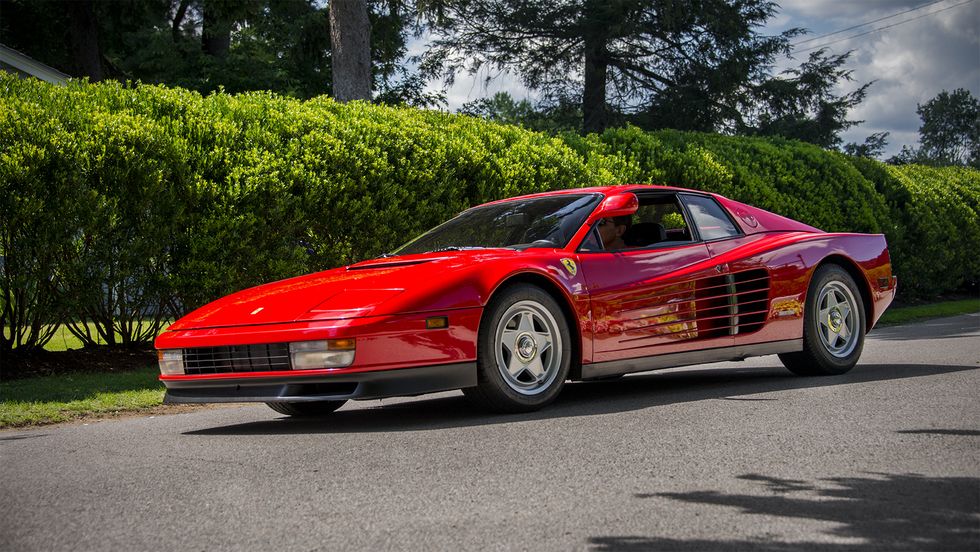If you enjoy reading about revolutionary cars, let us know. If you want to see a specific model in an upcoming article, send us an email or a direct message on Instagram. We are currently working on the sequel of the article as there are many more timeless cars worth mentioning.
1. Porsche 911 (993)
Who wouldn’t know the 911? Ferdinand Porsche’s iconic sports car. Air-cooled, straight-six boxer engine and good old rear-wheel drive. We believe there are no car enthusiasts who would not appreciate the history and performance of the 911. It’s a statement in the automotive industry.

A little history. Many people associate Porsche with the 911. While the 911 is Porsche’s best-known car, the brand didn’t start with the 911. Their first car was named the 356. The succeeder was originally set to be sold as the 901 but French automaker Peugeot claimed the rights to three-digit car names with zero in the middle. So, Porsche changed the name of their future icon, and the 911 was born.
It’s hard to pick the best 911 because all the generations are incredible cars and have a unique feel. But if I have to pick one, I choose the 993 as it is my all-time favorite classic car. Its discontinuation marked the end of air-cooled 911 models. Many Porsche enthusiasts think this is the last real 911. The 993 had many improvements from the predecessor, such as a new light-alloy subframe with coil and wishbone suspension. It was also the first 911 to receive a six-speed transmission.
2. Ferrari Testarossa
We can try all day to list all the iconic Ferrari models, but we wouldn’t reach the end of the list. The Maranello-based company has provided us with so many exceptional cars. It would be easier to list models that have not been successful because there are so few.
We choose the Testarossa as one of the most iconic Ferraris. It is the childhood dream car of many of us. The Ferrari Testarossa is a 12-cylinder mid-engine sports car manufactured by Ferrari, which went into production in 1984 as the successor to the Ferrari Berlinetta Boxer.
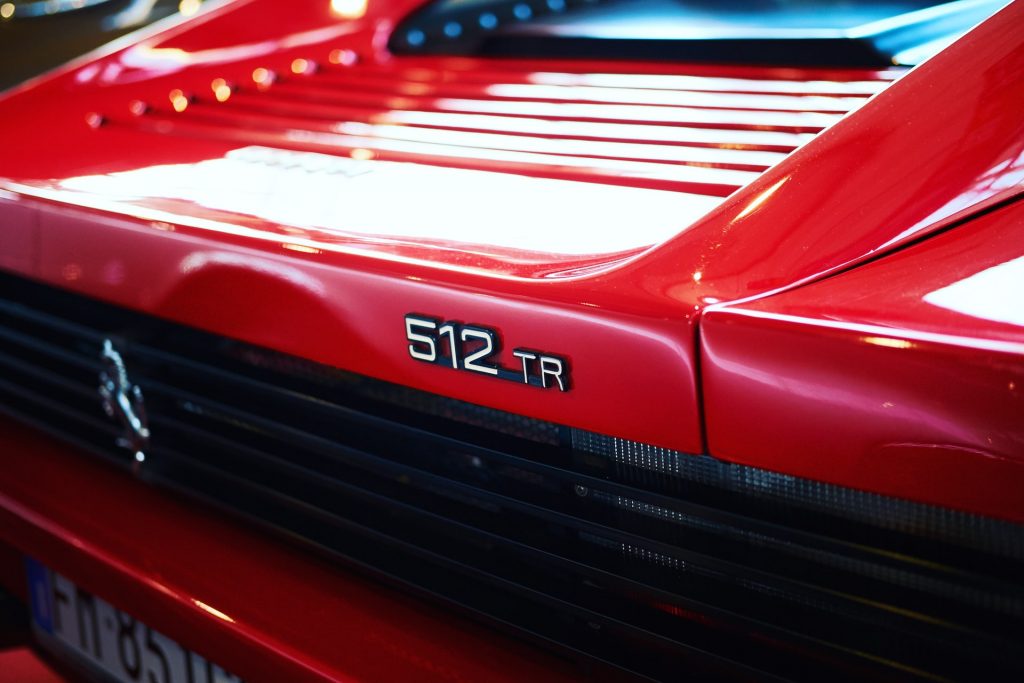
The Pininfarina-designed car was originally produced from 1984 to 1991, with two model revisions following the end of Testarossa production called the 512 TR and F512 M, which were produced from 1992 to 1996. Including revised variations, almost 10,000 cars in total were produced, making it one of the most mass-produced Ferrari models.
3. Alfa Romeo Tipo 33 Stradale
Not only is it one of the rarest cars ever produced by Alfa Romeo, but it is also one of the most expensive cars ever sold. It was designed by Franco Scaglione and presented at the 1967 Turin Motor Show. Underneath the streamlined lampshades, originally two headlights were placed, one below the other on each side. The bottoms were so low that they would not be allowed on the road, so they had to be redesigned. For practical reasons, the single wiper was also replaced with two traditional pieces.
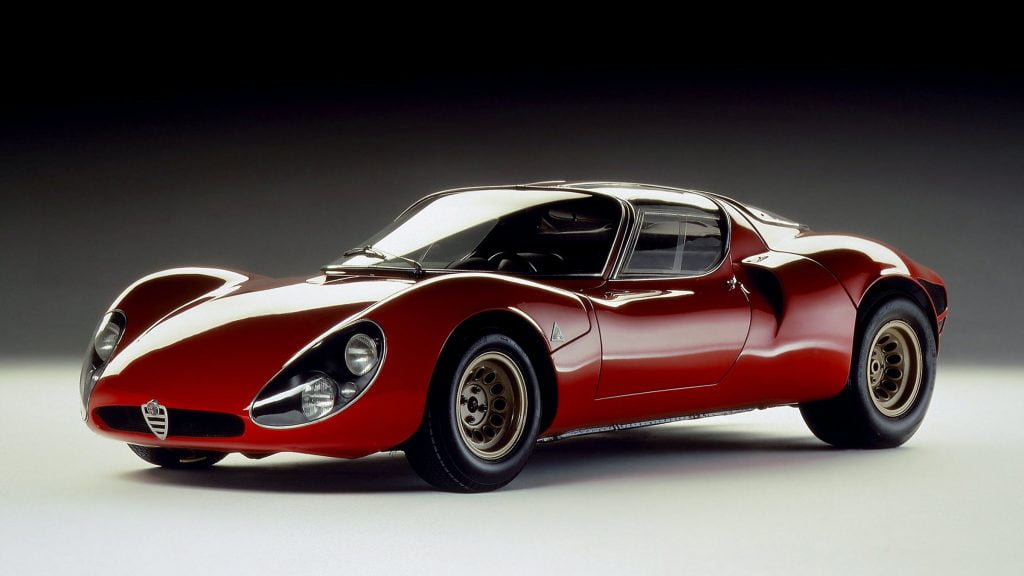
The car takes less than 6 seconds to reach 100 km/h from a standing start and has a top speed of 260 km/h. In 1968 it was the fastest commercially available car over the standing kilometer with a time of 24.0 seconds. Similar performance cars at that time were all using twice the Stradale`s cylinder capacity such as the Lamborghini Miura, Ferrari Daytona, and Maserati Ghibli.
If you were thinking about purchasing this rare Alfa, the estimated price would be around $10,000,000. Of course, if you can find a seller.
4. Jaguar XJ220
Jaguars have a stronger bite than any other big cat. The XJ220 was no different in the automotive industry.
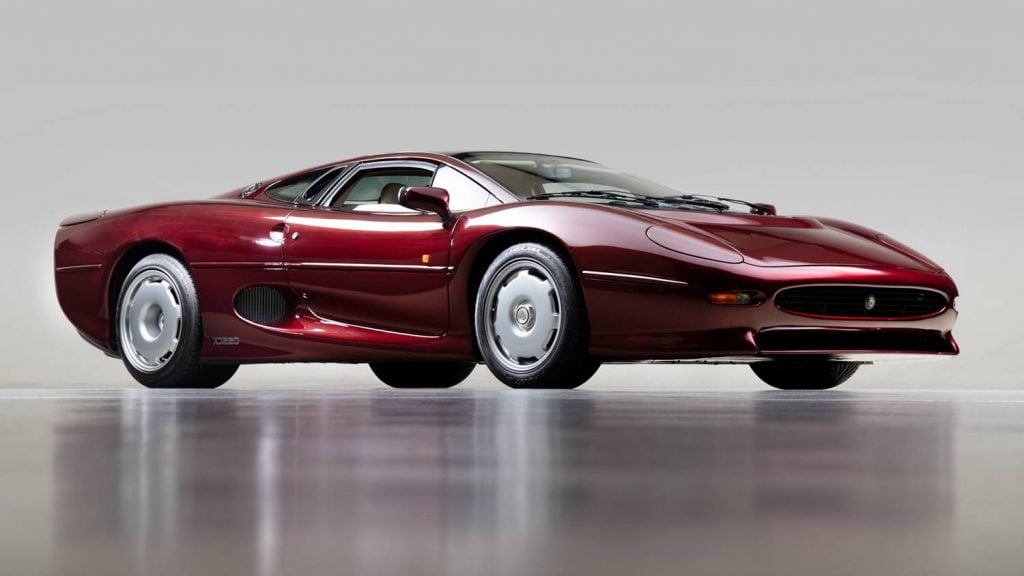
The Jaguar XJ220 is a two-seat sports car produced by British luxury car manufacturer Jaguar from 1992 till 1994. It was a collaboration with the specialist automotive and race engineering company Tom Walkinshaw Racing. The XJ220 recorded a top speed of 212.3 mph (341.7 km/h) during testing by Jaguar at the Nardo test track in Italy, which made it the fastest production car from 1992 to 1993. According to Jaguar, an XJ220 prototype managed a Nürburgring lap time of 7:46.36 in 1991, which was faster than any production car’s lap time before it.
The production version of the XJ220 used a 3,498 cc (3.5 L) twin-turbocharged V6 engine. This engine, which replaced the Jaguar V12 featured in the concept car, was a heavily redesigned and significantly altered version of the Austin Rover V64V V6 engine.
The decision to replace the engine was made based on the weight and dimensions of the motor. Also, for environmental emission considerations. The shorter V6 engine design allowed the wheelbase of the XJ220 to be shorter and its weight to lower. The V12 engine was definitively ruled out when it was determined it would have difficulty at simultaneously meeting emissions legislations.
5. Mercedes-Benz 300 SL
The Mercedes Benz 300SL has been introduced nearly 70 years ago, yet the design is undoubtedly beautiful to this day.

The Mercedes-Benz 300 SL was a two-seater sports car, available in two versions. The coupe version was first introduced in 1954 and the roadster in 1957. It was based on the company’s 1952 racing car, the W194, with direct mechanical fuel injection, which increased the performance of the 3-liter crankshaft straight-6 engine by almost 50%. Capable of reaching a top speed of 263 km/h (163 mph), it was both a sports car champion and the fastest mass-produced car of its time.
6. Maserati 3500 GT
One thing is sure. Italians know how to make timeless masterpieces, from chassis design to the sound of naturally aspirated engines. They made many revolutionary and timeless vehicles.

The 3500 GT was Maserati’s first effort in the world of Gran Turismo and “regular” series-produced cars. It was manufactured between 1957 and 1964. The 3500 GT came in two versions, the two-door coupe and the more common drop-top form.
The GT was powered by a modified version of the DOHC, 12-valve straight-six engine of the endurance racing Maserati 350S which had been modified to suit a touring car by switching to a wet sump oil system. It was a naturally aspirated engine of a 3.5-liter capacity.
This unit featured double overhead camshaft valve gear, a six-cylinder layout, and two valves per cylinder. It developed 265 bhp (269 PS / 198 kW) of power at 5500 RPM and maximum torque of 354 Nm at 4000 RPM. A 5-speed manual transmission transferred the power to the driven wheels. It is said to be able to reach a top speed of 235 km / h (146 mph).
7. BMW M1
The BMW M1 is one if not the rarest cars ever produced. It is the love affair between BMW and Lamborghini. The BMW M1 (model code E26) is a mid-engined sports car produced by BMW from 1978 to 1981.

In the late 1970s, Italian automobile manufacturer Lamborghini agreed with BMW to build a production racing car in sufficient quantity for homologation, but conflicts arose that prompted BMW to produce the car themselves. The resulting car was sold to the public, from 1978 to 1981, as the BMW M1.
It is the first mid-engine BMW automobile to be mass-produced – the second is the i8 plug-in hybrid sports car. For such a legendary car, the BMW M1 was one hell of a failure. Designed to take the racing world by storm, it ended up getting lost in the changing tides of the era, only to disappear after three short years.
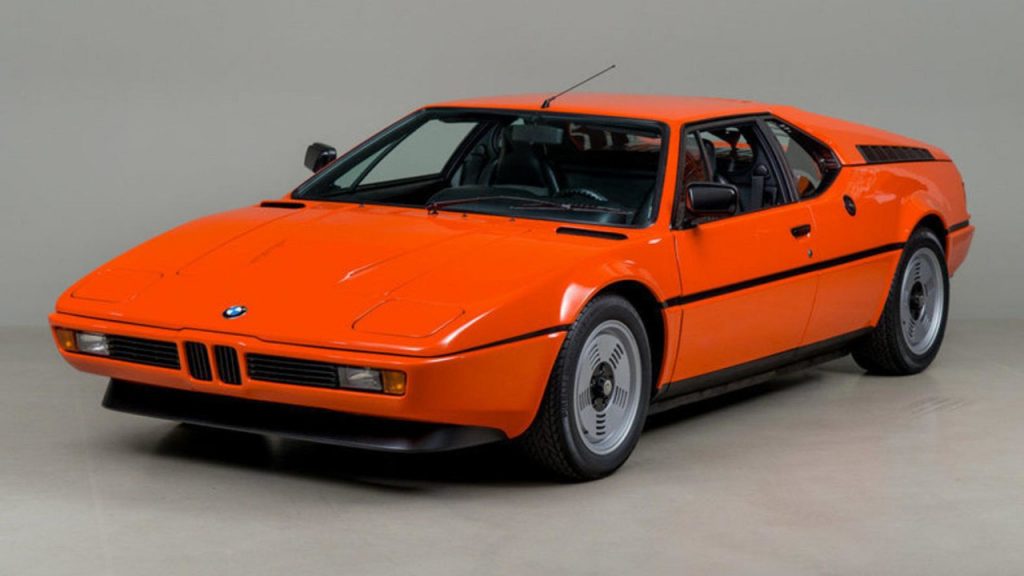
But what a failure it was; as Car and Driver put it in 1981: “The M1 might have been the right car at the wrong time, but every driver deserves a turn at the wheel of what is probably the best fast car ever built.”
According to BMW M, the pure performance data of the M1 engine remains evident today. The 6-cylinder in-line petrol engine of the road version delivers 204 kW (277 hp) and generates a maximum torque of 330 Nm. It draws this power from 3.5 liters of displacement. Its four valves per cylinder, which work together with mechanical injection were far ahead of their time, while its impressive top speed of around 265 km/h made the BMW M1 the fastest German road sports car of the era.
8. Aston Martin DB5
We wouldn’t make a list without a classic Aston Martin. The famous car of Mr. James Bond is featured in many movies such as GoldenEye, The World Is Not Enough, or Tomorrow Never Dies, just to name a few. The Aston Martin DB5 is a British luxury grand tourer (GT) that was manufactured by Aston Martin and designed by the Italian coachbuilder Carrozzeria Touring Superleggera. Released in 1963, it was an evolution of the final series of DB4.

Although not the first in the DB series, the DB5 is the best-known cinematic James Bond car. It first appeared in James Bond Goldfinger in 1964 and returned in the latest movie No Time To Die.
The principal differences between the DB4 Series V and the DB5 are the all-aluminum engines, enlarged from 3.7 L to 4.0 L, a new robust ZF five-speed transmission (except for some of the very first DB5s), and three SU carburetors. This engine, producing 282 bhp (210 kW), which propelled the car to 145 mph (233 km/h), available on the Vantage (high powered) version of the DB4 since March 1962, became the standard Aston Martin power unit with the launch in September 1963 of the DB5.
9. Lamborghini Miura (P400)
The Italian car brand Lamborghini makes one of the most astonishing cars to this day with their unique naturally aspirated V10 and V12 engines. The P400 was the first supercar with a rear mid-engined two-seat layout, which has since become the standard for high-performance sports and supercars.
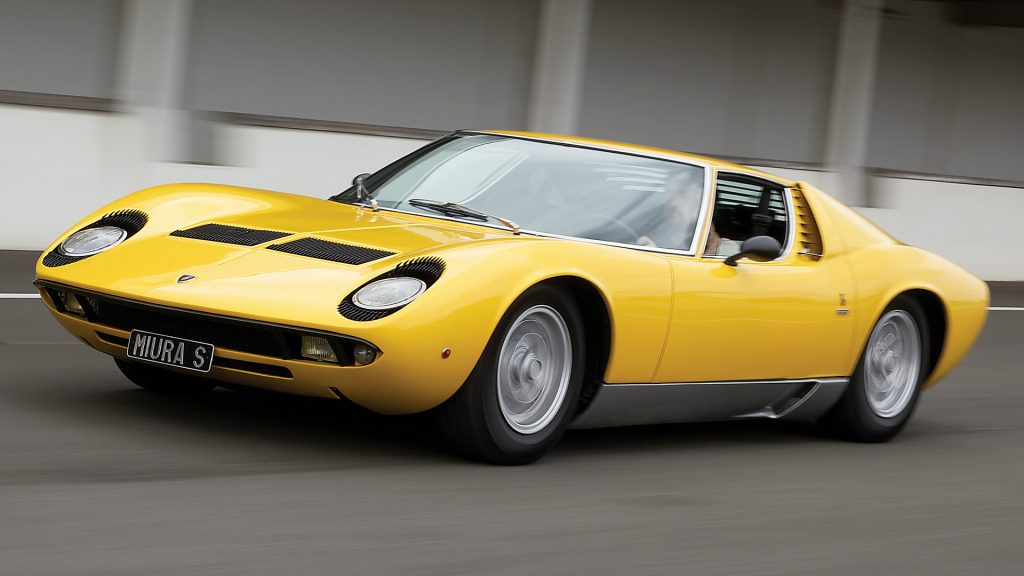
The Miura wasn’t the first car to be produced by Lamborghini, but it was a breakthrough for the brand and the industry. During 1965, three of Lamborghini’s top engineers, Gian Paolo Dallara, Paolo Stanzani, and Bob Wallace, devoted their time to develop a prototype called the P400, that they envisioned as a road car with racing pedigree, capable of winning on the track as well as being driven on the road by car lovers.
The earliest model of the Miura was known as the P400 (for Posteriore 4 liter). It was powered by a version of the 3.9 L Lamborghini V12 engine used in the 400GT at the time. The engine was mounted transversely and produced 350 PS (257 kW; 345 hp). The Miura was the fastest production car in the world at its time, with a top speed of 163 mph and 0 to 60 mph in 6.3 seconds.
10. Ford GT40
The car may look familiar to you from the movie Ford v Ferrari. The Ford GT40 was an American high-performance endurance racing car. The first three variants were designed and built in the UK based upon the Lola Mk6 during the early 1960s. The Mk IV model was designed and built in the United States. The range was powered by a series of American-built Ford V8 engines modified for racing. Initially, the GT40 was not a competitive success until the project was relocated to the US, where further changes improved the car’s performance and reliability.
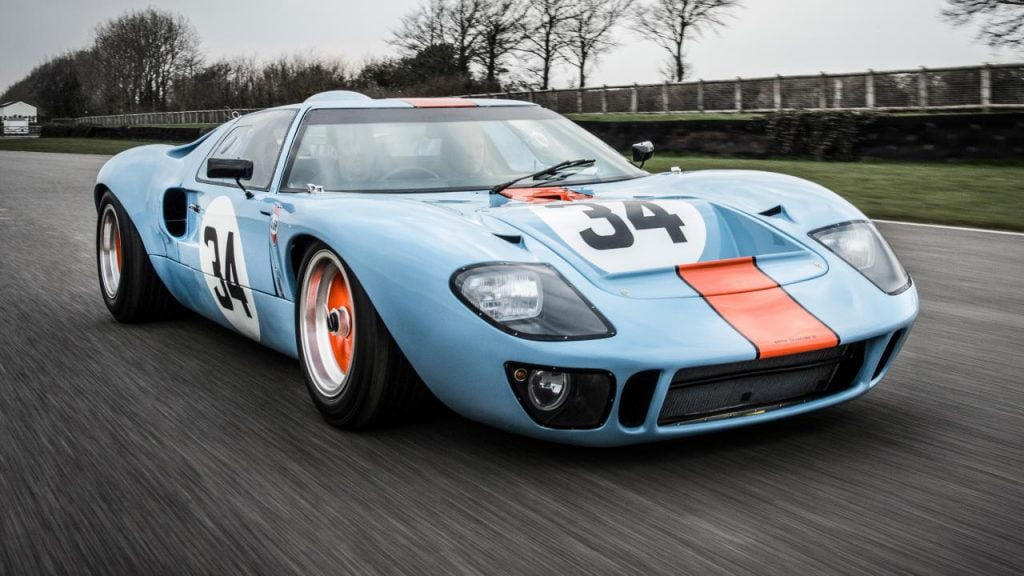
GT40 at Le Mans
Finally, the GT40 was launched by Ford Motor Company to win long-distance sports car races against Ferrari, which won every 24 Hours of Le Man’s race from 1960 to 1965. The GT40 broke Ferrari’s streak in 1966 and went on to win the next three annual races. The Mk II’s victory was the first win for an American manufacturer in a major European race since Jimmy Murphy’s triumph with Duesenberg at the 1921 French Grand Prix. In 1967, the Mk IV became the only car designed and built entirely in the United States to achieve the overall win at Le Mans.

Nowadays, the Gulf-painted GT40 is a cult car in car circles.
Since the Mk II was the first version to win at Le Mans, we will present this in more detail. The Mk II was rebuilt by Holman Moody in California to handle the 7.0-liter engine from the Ford Galaxie. The Galaxie’s engine was previously used in NASCAR at the time and modified for road usage. The car’s chassis was similar to the British-built Mk I chassis, but several parts of the vehicle had to be redesigned and modified by Holman Moody to accommodate the larger and heavier engine. A new Kar Kraft-built four-speed gearbox replaced the ZF five-speed used in the Mk I.
In 1966, the three teams racing the Mk II (Chris Amon and Bruce McLaren, Denis Hulme and Ken Miles, Dick Hutcherson and Ronnie Bucknum) dominated Le Mans, taking European audiences by surprise and beating Ferrari to finish 1-2-3 in the standings. The Ford GT40 went on to win the race for the next three years.
Keep on reading: Ferrari 308 GTB/GTS – A Piece of the Italian History

